
Cannelton Cotton Mill, also known as Indiana Cotton Mill, is a National Historic Landmark of the United States located in Cannelton, Indiana, United States. Built in 1849 as an effort to expand textile milling out of New England, it was the largest industrial building west of the Allegheny Mountains, designed by Thomas Alexander Tefft, an early industrial architect. It was declared a National Historic Landmark in 1991. The building now houses residences.

The Slater Mill is a historic textile mill complex on the banks of the Blackstone River in Pawtucket, Rhode Island, modeled after cotton spinning mills first established in England. It is the first water-powered cotton spinning mill in North America to utilize the Arkwright system of cotton spinning as developed by Richard Arkwright.

Harmony Mills, in Cohoes, New York, United States, is an industrial district that is bordered by the Mohawk River and the tracks of the former Troy and Schenectady Railroad. It was listed as Harmony Mills Historic District on the National Register of Historic Places in 1978. A portion of the district encompassing the industrial buildings and some of the housing built for millworkers was declared a National Historic Landmark in 1999. The centerpiece building, Harmony Mill No. 3 was listed on the National Register of Historic Places in 1971.

Hook Windmill, also known as Old Hook Mill, is a historic windmill on North Main Street in East Hampton, New York. It was built in 1806 and operated regularly until 1908. One of the most complete of the existing windmills on Long Island, the windmill was sold to the town of East Hampton in 1922. The building was listed on the National Register of Historic Places in 1978 and is part of the North Main Street Historic District. The mill was renamed the "Old Hook Mill" and is open daily to visitors. The Windmill is among the 11 other surviving 18th and early 19th century wind-powered gristmills located on Long Island. It was built by Nathaniel Dominy V, a well-known East Hampton craftsman.
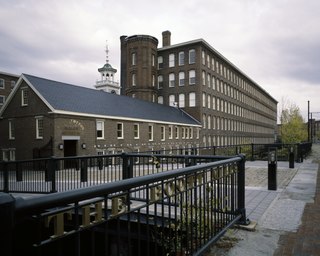
The Boott Mills in Lowell, Massachusetts were a part of an extensive group of cotton mills, built in 1835 alongside a power canal system in this important cotton town. Their founder was Kirk Boott, one of the early mill owners in Lowell. Today, the Boott Mills complex is the most intact in Lowell and is part of Lowell National Historical Park. It houses the Boott Cotton Mills Museum.
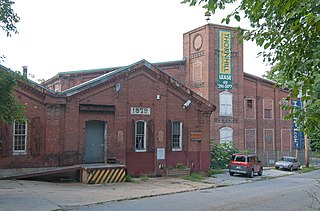
Mount Vernon Mill No. 1 is a historic cotton mill complex located at Baltimore, Maryland, United States. It was constructed between 1873 and 1918 and consists of four buildings situated along Jones Falls. The complex consists of three closely associated 19th century buildings and a 20th-century warehouse. There is a large, three-story brick Mill Building (1873); a two-story, brick, "L"-shaped Picker House (1873); a two-story, brick Store House ; and a later, reinforced-concrete warehouse (1918). It served as headquarters for Mount Vernon-Woodberry Mills, one of the world's largest producers of cotton duck.

Riverview Historic District is a historic district along the Chattahoochee River in River View, Alabama. It was listed on the Alabama Register of Landmarks and Heritage on December 19, 1991 and on the National Register of Historic Places on November 12, 1999.

Price's Mill, also known as Calliham's (Callaham's) Mill, Stone's Mill, and Park's Mill, is a water-powered gristmill about 2 mi (3 km) east of the town of Parksville on South Carolina Highway 33-138 at Stevens Creek in McCormick County. Its name in the USGS Geographic Names Information System is Prices Mill. It was built in the 1890s and was named to the National Register of Historic Places on November 22, 1972. At this time, it was one of the few remaining water-powered gristmills in South Carolina.
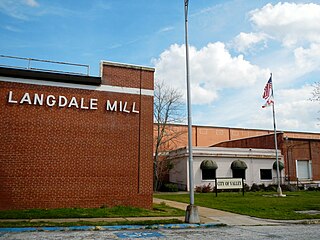
Langdale Historic District is a historic district in Valley, Alabama and Harris County, Georgia, United States. It was listed on the Alabama Register of Landmarks and Heritage on July 22, 1991 and the National Register of Historic Places (NRHP) on November 12, 1999. It lies primarily in Valley, Alabama, on the West side of the Chattahoochee River.
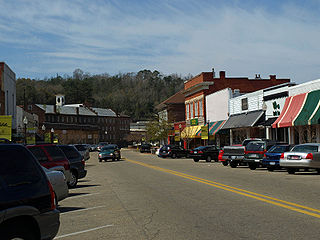
The Daniel Pratt Historic District is a historic district that includes 140 acres (57 ha) and 154 buildings in Prattville, Alabama. It is named in honor of Prattville's founder, Daniel Pratt. The district includes the historic downtown and is roughly bounded by 6th Street in the north, Northington Street in the east, 1st Street in the south, and Bridge and Court streets in the west. Architecture in the district includes the Greek Revival, Italianate, and Bungalow styles. It was listed on the National Register of Historic Places on August 30, 1984.
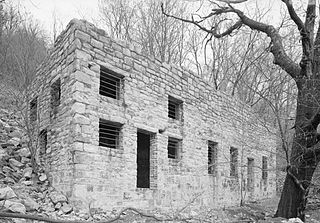
Harbison-Walker Refractories Company originated as the Star Firebrick Company on March 7, 1865, with Articles of Association by a group of Pittsburgh and Allegheny residents. On January 30, 1875, Hay Walker Sr. and Samuel P. Harbison entered Articles of Agreement to purchase the interests in Star Fire Brick Company and formed the Harbison and Walker Company. Then on July 30, 1894, Harbison & Walker was incorporated under the laws of the Commonwealth of Pennsylvania, finally being chartered as Harbison-Walker Refractories Company by the Commonwealth of Pennsylvania on June 30, 1902. Ultimately this company was merged into Dresser Industries in 1967.

Sams Plantation Complex Tabby Ruins is a historic plantation complex and archaeological site located at Frogmore, Beaufort County, South Carolina. The site, possibly built upon and occupied well before 1783. It includes the ruins and/or archaeological remains of at least 12 tabby structures. They include the main plantation house, a rectangular enclosure consisting of tabby walls, a large tabby kitchen, and five tabby slave quarters. Also on the property were a variety of tabby dependencies including a barn/stable, a smoke house or blade house, a well/dairy house, and a well. The property also includes the Sams family cemetery and Episcopal chapel enclosed by high tabby walls. Other structures include possibly an overseer's house, a granary/mill, and a tabby cotton house. During and subsequent to the American Civil War the Sams Tabby Complex was occupied by freedman. Following the Civil War the plantation house was destroyed by hurricanes.

Browntown is a national historic district located near Johnsonville, Florence County, South Carolina. The district encompasses 7 contributing buildings and 4 contributing structures reflecting the self-sufficient way of life practiced by several generations of the Brown family during the 19th and early-20th centuries. Moses Brown and his son and grandsons were self-sufficient farmers who operated their own brick kiln, grist mill, lumber mill, cotton gin, retail and wholesale mercantile business, and school. The property nominated includes the cotton gin building, three residences, the school, a tobacco barn, and several outbuildings. Browntown includes examples of both log and frame construction, and are grouped in two complexes, one group adjacent to the road and the other across the fields around the cotton gin building.
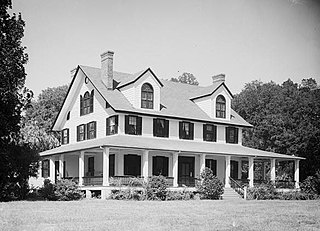
Pee Dee River Rice Planters Historic District is a set of historic rice plantation properties and national historic district located near Georgetown, Georgetown County, South Carolina.
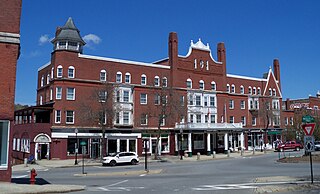
The Central Business District of Claremont, New Hampshire, is centered on Broad Street Park and the Claremont Opera House, and the area between the park and the Sugar River, whose power was responsible for Claremont's growth in the 19th century. The district was listed on the National Register of Historic Places in 1978.

The Monadnock Mills are a historic mill complex in Claremont, New Hampshire. They extend along the southern bank of the Sugar River on both sides of Water Street, between the Broad Street bridge to the east, and the junction of Main and Water Streets in the west, where they abut the industrial area formerly associated with the Sullivan Machinery Company; there also a small number of surviving elements on the north side of the river opposite this area. The complex represents the surviving elements of what was once the largest manufacturing complex in the upper Connecticut River watershed area, and one of its oldest. The mills were listed on the National Register of Historic Places in 1979. Many of its buildings have been repurposed to other uses.

Williams Place is a historic home and farm complex located near Glenn Springs, Spartanburg County, South Carolina. It was developed between about 1839 and 1850, and includes 10 contributing buildings, 1 contributing site, and 2 contributing structures. The majority of the buildings are of log construction and include a small house, a large house, a kitchen, a smokehouse, a smithy, two corn cribs, a ruined house, and barn / stable. Frame buildings and structures include a privy and a barn. Also on the property are a well and an earthen dam.

Winthrop College Historic District is a national historic district located on the campus of Winthrop University at Rock Hill, South Carolina. It encompasses 17 contributing buildings and 1 contributing structure constructed between 1894 and 1943. Architectural styles represented include Gothic Revival, Richardsonian Romanesque, Classical Revival, and Colonial Revival. Notable buildings include the separately listed Tillman Hall and Withers Building, as well as Alumni House, Phelps Dormitory, Thurmond Building, Byrnes Auditorium, Johnson Hall, and the President's Residence.

Glencoe Mill Village Historic District is a national historic district located at Glencoe, Alamance County, North Carolina. It encompasses 48 contributing buildings and 6 contributing structures built between 1880 and 1882 in Glencoe.

Capitola Manufacturing Company Cotton Yarn Mill, also known as the Marshall Mill and Power Company, is a historic cotton mill complex located at Marshall, Madison County, North Carolina. The main mill building is a three-story brick building built about 1905. It was raised to three stories in 1928. It measures approximately 108 feet (33 m) by 116 feet (35 m), with a low-pitched gabled roof, and windows on three sides. Also on the property is a contributing boiler house and water tank.
























